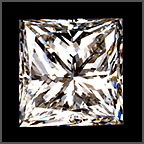Princess Cut
[ Edit This Page ] [ Report This Entry ] [ View History ]

The princess cut, as shown above is a square brilliant cut, second only in popularity to the round brilliant cut.
History
The princess cut has its origins in 1961, when Aprad Nagy developed what is now known as the "Profile Cut". Since Nagy's cut was much flatter, the modern day princess cut is now attributed to Basil Watermeyer, a diamond cutter from Johannesburg, who in 1971 developed developed the Barion Cut, which was either square, or square-octagonal, with a characteristic cross viewable through the table.
Rise in Popularity
As mentioned before, the princess cut is now the second most popular shape. This could be attributed to the fact that the princess cut is more brilliant and sparkly that other square or square-octangonal diamonds. It could also be because patents made on the princess cut have expired within the last ten years, making them readily available.
Properties
The princess cut usually has 76 facets, but there are other versions with at least 45 facets such as:
- 50 facets (21 crown, 4 girdle, 25 pavilion)
- 58 facets (21 crown, 4 girdle, 33 pavilion)
- Up to 144 facets, depending on how the pavilion is cut.
Ideally, the princess cut should be square, that is a 1:1 length to width ratio. Typically however, the length to width ratio ranges from 1 to 1.15:1.
Traditionally, grading labs have not graded the cut quality of the princess cut. However, the AGS now grades princess cuts based on their light performance.
Problem Corners
The princess cut has four pointed corners that are both prone to chipping and light leakage. This has lead to cuts being developed with tapered corners such as The Regent, The Dream and The Tiffany Lucida, however "by tapering the corners of the diamond you are essentially negating the traditional and timeless look of the princess cut diamond".
Cost
Although the princess cut sells, for up to 20% less than the round brilliant, it is important to remember that for the same carat weight, the spread of a princess cut will be less than the round brilliant. It should also be noted that the princess cut wastes the least amount of the rough diamond in order to produce a polished stone.
External Links
Princess Cut Information via Chards
via Chards
The Princess Cut Diamond by Whiteflash
by Whiteflash